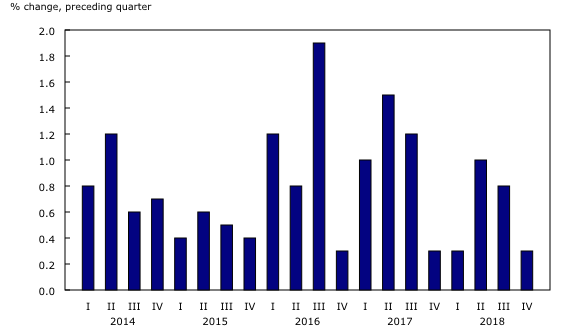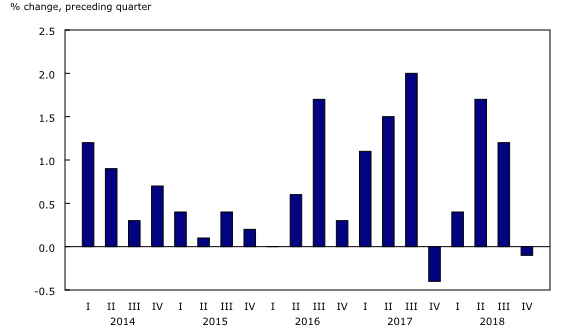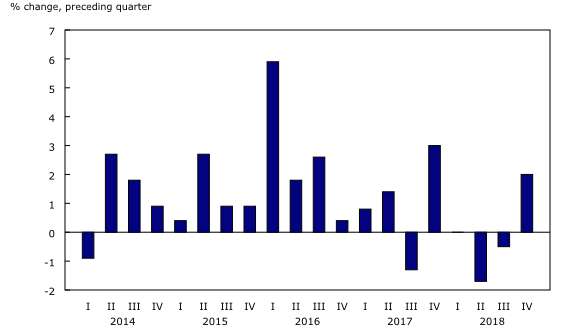National tourism indicators, fourth quarter 2018
Archived Content
Information identified as archived is provided for reference, research or recordkeeping purposes. It is not subject to the Government of Canada Web Standards and has not been altered or updated since it was archived. Please "contact us" to request a format other than those available.
Released: 2019-03-28
$24.1 billion
Fourth quarter 2018
0.3% 
(quarterly change)
Tourism spending in Canada rose 0.3% in the fourth quarter, following a 0.8% gain in the third quarter. Increased spending by international visitors to Canada was partially offset by lower spending by Canadians in Canada. Annually, tourism spending in Canada rose 2.8% in 2018, following a 4.3% gain in 2017.
Tourism spending by Canadians edges down
Tourism spending by Canadians in Canada edged down 0.1% in the fourth quarter following a 1.2% increase in the third quarter. Despite the slight decline in the fourth quarter, domestic tourism spending was up 3.3% annually in 2018.
Tourism spending varied across tourism goods and services in the fourth quarter. Passenger air transport was unchanged for the quarter, following growth throughout the earlier part of the year. Interurban bus transport (-19.8%) and food and beverage services (-0.6%) declined, while accommodation (+1.0%) and travel services (+1.8%) increased.
Tourism spending by international visitors increases
Tourism spending by international visitors to Canada increased 2.0% in the fourth quarter, after two consecutive quarters of decline. Annually, tourism spending by international visitors rose 0.8% in 2018, following a 4.0% increase in 2017.
Outlays on accommodation (+3.1%), food and beverage services (+3.1%), recreation and entertainment (+3.1%) and passenger air transport (+1.4%) were all higher in the fourth quarter.
Both overnight travel from abroad and same-day car travel from the United States increased.
Tourism gross domestic product increases
Tourism gross domestic product (GDP) rose 0.2% in the fourth quarter, following a 0.7% increase in the third quarter. By comparison, economy-wide GDP was up 0.1% in the fourth quarter.
Tourism GDP in the accommodation industry (+2.0%) was the main contributor to economic growth. This was partially offset by lower tourism GDP in transportation industries (-0.9%).
Annually, tourism GDP rose 2.7% in 2018 following a 4.0% increase in 2017. By comparison, economy-wide GDP rose 1.8% in 2018. The share of tourism in the Canadian economy increased from 2.0% in 2017 to 2.1% in 2018.
Tourism employment is stable
Tourism employment was unchanged in the fourth quarter, following a 0.4% gain the previous quarter. Tourism jobs in food and beverage services (+0.4%), recreation and entertainment (+1.0%) and accommodation (+0.4%) industries all rose. Tourism jobs in non-tourism industries (+0.6%) also increased while jobs in other transportation (-7.1%) and air transportation (-0.9%) industries declined. Annually, the number of tourism jobs grew 0.5% in 2018, following 2.0% growth the previous year.
Sustainable development goals
On January 1, 2016, the world officially began implementation of the 2030 Agenda for Sustainable Development, the United Nations' transformative plan of action that addresses urgent global challenges over the next 15 years. The plan is based on 17 specific sustainable development goals.
The national tourism indicators are an example of how Statistics Canada supports the reporting on the Global Goals for Sustainable Development. This release will be used in helping to measure the following goal:

Note to readers
Growth rates for tourism spending and gross domestic product (GDP) are expressed in real terms (that is, adjusted for price changes), using reference year 2012, as well as adjusted for seasonal variations, unless otherwise indicated. Employment data are also seasonally adjusted. For information on seasonal adjustment, see Seasonally adjusted data – Frequently asked questions.
Associated percentage changes are presented at quarterly rates unless otherwise noted.
With the fourth quarter of 2018 release of the national tourism indicators, all data for the first, second and third quarters of 2018 have been revised.
Economy-wide GDP is obtained from table 36-10-0104-01, which incorporates legal and illegal economic activities related to cannabis for non-medical and medical use, which have been incorporated in national accounts time series back to 1961 to preserve time series continuity. Non-medical use became legal on October 17, 2018.
The national tourism indicators are funded by Destination Canada.
Next release
Data on the national tourism indicators for the first quarter will be released on June 27.
Products
The document, "The 2015 to 2018 revisions of the National Tourism Indicators," which is part of Latest Developments in the Canadian Economic Accounts (13-605-X), is now available.
The data visualization product "Provincial and Territorial Tourism Satellite Account," which is part of Statistics Canada – Data Visualization Products (71-607-X), is available.
The User Guide: Canadian System of Macroeconomic Accounts (13-606-G) is available.
The Methodological Guide: Canadian System of Macroeconomic Accounts (13-607-X) is available.
Contact information
For more information, or to enquire about the concepts, methods or data quality of this release, contact us (toll-free 1-800-263-1136; 514-283-8300; STATCAN.infostats-infostats.STATCAN@canada.ca) or Media Relations (613-951-4636; STATCAN.mediahotline-ligneinfomedias.STATCAN@canada.ca).
- Date modified:




